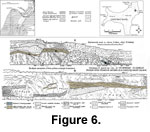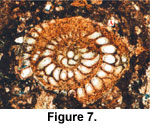THE CHRISTMAS ISLAND EOCENE FAUNA
 An obvious omission to the data set was the Eocene of Christmas Island in the Indian Ocean south of Java, on the oceanic plate bordering the Australian
plate (Figure 6). This locality is fixed to the northern flank of the Australian Plate and has drifted north towards Java at the same rate. In the Eocene it would have been at equivalent latitudes to the Northwest shelf of Australia and further south than many parts of
Papua/PNG. Eocene strata are known from this area from the work of Jones and Chapman
(Andrews 1900), who identified
Discocyclina here. Later work on the older Tertiary faunas is limited, so samples were collected for me in November 2001 by J. Jaworski and are the subject of this review.
An obvious omission to the data set was the Eocene of Christmas Island in the Indian Ocean south of Java, on the oceanic plate bordering the Australian
plate (Figure 6). This locality is fixed to the northern flank of the Australian Plate and has drifted north towards Java at the same rate. In the Eocene it would have been at equivalent latitudes to the Northwest shelf of Australia and further south than many parts of
Papua/PNG. Eocene strata are known from this area from the work of Jones and Chapman
(Andrews 1900), who identified
Discocyclina here. Later work on the older Tertiary faunas is limited, so samples were collected for me in November 2001 by J. Jaworski and are the subject of this review.
Summary
 The fauna does not vary much from that described by Jones and Chapman, with Discocyclina and a large
Heterostegine, named here as Grzybowskia jasoni dominating all the older Tertiary samples collected. None of the previous workers have described any other Eocene assemblage. A typical view of the whole rock and fauna is shown in
Figure 7.
The fauna does not vary much from that described by Jones and Chapman, with Discocyclina and a large
Heterostegine, named here as Grzybowskia jasoni dominating all the older Tertiary samples collected. None of the previous workers have described any other Eocene assemblage. A typical view of the whole rock and fauna is shown in
Figure 7.
History of Study
Jones and Chapman studied samples collected by Andrews
(1900) and reported
Discocyclina and common large Heterostegines, but equally noted the absence of
Nummulites. At this time the definitions of the Eocene and Oligocene were not precise, so these early workers assigned a broad Oligocene or Eocene age to the
Discocyclina-bearing beds. In 1926 Nuttall studied the Orbitoides of Christmas Island and established the new species
Discocyclina oceanica in the Eocene, defined at the same location as the samples studied here, but he did not study the
Nummulitacea. In 1965 Ludbrook wrote a short account of the Tertiary
foraminifera, in which the oldest limestones of Andrews (called "A" and "B") were grouped as one unit and described as having the same
lithologic and faunal composition. The fauna was described as consisting of
Discocyclina oceanica, "Heterostegina sp. cf. H. saipanensis," or sometimes just
H. saipanensis - a form that had been defined by Cole in 1953 on Saipan Island in the Pacific - with associated
Sphaerogypsina globula, species of Pararotalia, Amphistegina, and rare
Nummulites [apparently a single occurrence] seen only in a "natural section on one of the samples" from Flying Fish Cove.
Most recently Adams and Belford (1974) studied a large number of samples from Christmas Island, but this work was focused on the
Oligo-Miocene limestones, and the occurrence of Eocene was only noted in passing. In the most famous Eocene outcrop at Flying Fish Cove there is a natural geological break between these two limestone groups in the form of a basalt flow that overlies the Eocene, and this basalt is the base of the section Adams and Belford studied. The age of this basalt has been determined by J. Hamilton of CSIRO as
K = 0.82 wt%
Rad. 40Ar = 4.7116E-11 (mol/g)
Rad. 40Ar = 36.05 (%)
Age = 32.8 Ma, analytical error 0.8 Ma.
This Early Oligocene age is consistent with its stratigraphic position between Eocene limestone and the lower Te (Late Oligocene) limestone reported by
Adams and Belford (1974).
In 2001, a wide range of samples were collected at the Flying Fish Cove site, from both the yellow and the white limestone facies (see
Figure 6). Andrews
(1900) described this site as "by far the most important exposure of the central core of the island." The limestone here is about 50 ft thick, although the base is not visible. Limestone samples were slabbed and polished to provide a large study area in reflected light, while 21 large format thin sections from different samples provided a total estimated area of about 350 sq cm of thin-sectioned rock. This sample set is thought to give a representative view of the Eocene larger foram fauna at Flying Fish Cove.
Two samples of the white limestone were analysed for whole rock strontium isotopic dating by T. Allan of
CSIRO. Results were:
87Sr/86Sr = 0.707630, 2 sem 0.0016%
0.707683, 2 sem 0.0013%
87Sr/86Sr ratios normalized to 86Sr/88Sr = 0.1194
87Sr/86Sr ratios normalized to NBS987
87Sr/86Sr = 0.710235
Measured NBS987 87Sr/86Sr = 0.710232
2 sem - 2 standard errors of the mean (2s/n)
Modern seawater (Mobil) 87Sr/86Sr = 0.709168
Attempts were made to find some of the other, much smaller Eocene locations reported by Andrews but with no success. The analyses of
Jones and Chapman (1900) suggested the fauna of these other areas was similar to that seen at Flying Fish Cove.The results were similar, but are slightly below most published minimum values for Tertiary seawater calibration curves. It is possible that the overlying oceanic basalt has contaminated the limestone. However, the results are within measurement error of a Late Eocene limestone from Java (unpublished, Gamping Barat location, same labs; 0.707637, 2sem 0.0012%). These results are all slightly lower than Middle Eocene bioclasts with excellent preservation from the Nanggulan section on Java (same labs; 0.707722, 2 sem 0.0017%). This additional data is also courtesy of T. Allan and
CSIRO, who have observed similar low ratios in the Eocene of PNG. Therefore, it may be that the values measured in Flying Fish Cove do reflect true Sr ratios of the original limestone, and it is the correlation from these ratios to a time scale that needs more attention.
Palaeontology
The fauna recorded in this material is consistent with the summary of
Ludbrook (1965).
Discocyclina and the Heterosteginid form dominate, with frequent Sphaerogypsina globula and
Amphistegina. There is no discernable difference in fauna between the white, slightly porous limestone and the more massive (no visible porosity) yellow-orange
limestones, both of which are classified as foraminiferal packstones to
wackestones. The matrix in both types of rock is composed of lime mud, fragments of rhodolithic algae and small calcareous
foraminifera, brozoan and echinoid debris. The rhodolithic algae appears to be varied, but only rarely does it appear to encrust any
bioclasts, and then usually only bryozoan fragments. Only very rare planktonic foraminifera were recorded, and these examples were considered juvenile
Globigerina forms. Miliolid foraminfera are rare and represented only by small, thin-walled,
Quinqueloculina/Triloculina types. Most of the bioclastic debris is less than 2 mm in size, with the exception of the Discocylinids and
Heterosteginids. The Discocyclina oceanica are about 2 mm in diameter, a criteria used by Nuttall to distinguishing this species from the larger
D. dispansa Sowerby, to which the Christmas Island forms had originally been assigned by Jones and Chapman. The
Grzybowskia specimens range as large as 5 mm, and the Sphaerogypsina globula to 1.4 mm.
For brevity only the new form Grzybowskia jasoni is described here. Flying Fish Cove was the type location for the only other common form
Discocyclina oceanica Nuttall, and the specimens I saw were entirely consistent with
Nuttall's (1926) original detailed notes.

 An obvious omission to the data set was the Eocene of Christmas Island in the Indian Ocean south of Java, on the oceanic plate bordering the Australian
plate (Figure 6). This locality is fixed to the northern flank of the Australian Plate and has drifted north towards Java at the same rate. In the Eocene it would have been at equivalent latitudes to the Northwest shelf of Australia and further south than many parts of
Papua/PNG. Eocene strata are known from this area from the work of Jones and Chapman
(Andrews 1900), who identified
Discocyclina here. Later work on the older Tertiary faunas is limited, so samples were collected for me in November 2001 by J. Jaworski and are the subject of this review.
An obvious omission to the data set was the Eocene of Christmas Island in the Indian Ocean south of Java, on the oceanic plate bordering the Australian
plate (Figure 6). This locality is fixed to the northern flank of the Australian Plate and has drifted north towards Java at the same rate. In the Eocene it would have been at equivalent latitudes to the Northwest shelf of Australia and further south than many parts of
Papua/PNG. Eocene strata are known from this area from the work of Jones and Chapman
(Andrews 1900), who identified
Discocyclina here. Later work on the older Tertiary faunas is limited, so samples were collected for me in November 2001 by J. Jaworski and are the subject of this review.
